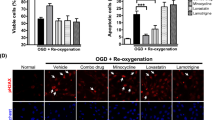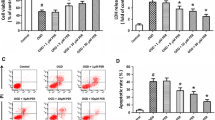Abstract
The blood-brain barrier possesses active transporters carrying brain-permeable xenobiotics back into the blood against concentration gradients. We demonstrate that multidrug resistance transporter (Mdr)-1 is upregulated on capillary endothelium after focal cerebral ischemia; moreover, Mdr-1 deactivation by pharmacological inhibition or genetic knockout preferably enhances the accumulation and efficacy of two neuroprotectants known as Mdr-1 substrates in the ischemic brain. We predict that Mdr-1 inhibition may greatly facilitate neuroprotective therapies.


Similar content being viewed by others
Change history
10 April 2006
Figure replaced
Notes
*Note: In the HTML version of this article originally published online, the layout of Figure 2 obscured the relationship between the key and the figure panels. The error has been corrected in the HTML version of the article.
References
Löscher, W. & Potschka, H. Nat. Rev. Neurosci. 6, 591–602 (2005).
Gottesman, M.M., Fojo, T. & Bates, S.E. Nat. Rev. Cancer 2, 48–58 (2002).
Wartenberg, M. et al. FASEB J. 17, 503–505 (2003).
Comerford, K.M. et al. Cancer Res. 62, 3387–3394 (2002).
Wang, Y. et al. Brain 128, 52–63 (2005).
Sharkey, J. & Butcher, S.P. Nature 371, 336–339 (1994).
Yulug, B., Kilic, Ü., Kilic, E. & Bähr, M. Brain Res. 996, 76–80 (2004).
Fisher, M. et al. Stroke therapy academic industry roundtable IV. Stroke 36, 1808–1913 (2005).
Sisodiya, S.M., Lin, W.-R., Squier, M.V. & Thom, M. Lancet 357, 42–43 (2001).
Potschka, H. & Löscher, W. J. Pharmacol. Exp. Ther. 301, 7–14 (2002).
Synold, T.W., Dussault, I. & Forman, B.M. Nat. Med. 7, 584–590 (2001).
Acknowledgements
We thank A. Fendel and M. Günthert for technical assistance and S. Krämer for stimulating discussions. This research was supported by the National Center of Competence in Research 'Neural plasticity and repair', Center of Integrative Human Physiology (CIHP), Swiss National Science Foundation (3200B0-100790/1), Baasch-Medicus Foundation and Hermann Klaus Foundation (to D.M.H.).
Author information
Authors and Affiliations
Corresponding author
Ethics declarations
Competing interests
The authors declare no competing financial interests.
Supplementary information
Supplementary Fig. 1
Mdr-1 expression is increased in the ischemic brain. (PDF 172 kb)
Supplementary Fig. 2
The Mdr-1 inhibitor TQD preferably increases brain concentrations of FK506 and rifampicin in the ischemic brain. (PDF 30 kb)
Supplementary Fig. 3
Regimen of TQD, FK506 and rifampicin (Rif) delivery used in order to study the role of the Mdr-1 transporter in post-ischemic neuroprotection. (PDF 24 kb)
Rights and permissions
About this article
Cite this article
Spudich, A., Kilic, E., Xing, H. et al. Inhibition of multidrug resistance transporter-1 facilitates neuroprotective therapies after focal cerebral ischemia. Nat Neurosci 9, 487–488 (2006). https://doi.org/10.1038/nn1676
Received:
Accepted:
Published:
Issue Date:
DOI: https://doi.org/10.1038/nn1676
- Springer Nature America, Inc.
This article is cited by
-
Gold Nanoparticles as Potential Antitumor Agents (Review)
Pharmaceutical Chemistry Journal (2021)
-
Time-of-Day Dependent Neuronal Injury After Ischemic Stroke: Implication of Circadian Clock Transcriptional Factor Bmal1 and Survival Kinase AKT
Molecular Neurobiology (2018)
-
Expression of P-Glycoprotein in the Blood-Brain Barrier and Its Interaction with Redox State in Cerebral Ischemia and Ischemia-Reperfusion
Neuroscience and Behavioral Physiology (2017)
-
Neurovascular remodeling in the aged ischemic brain
Journal of Neural Transmission (2015)





